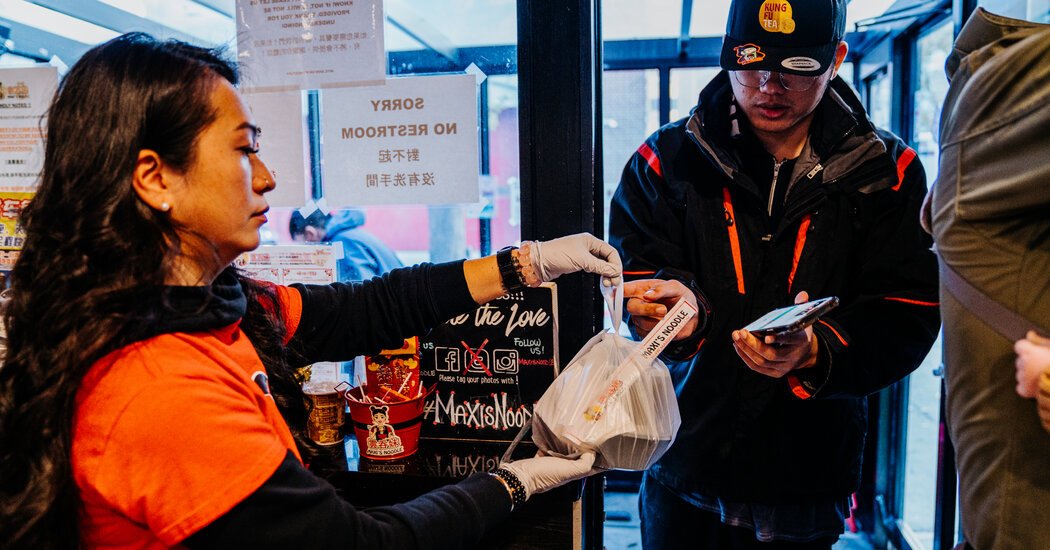[ad_1]
When Chong Zhou moved to New York City in 2013, she and her friends would organize entire days around trips to the Chinatown in Flushing, Queens, to eat, get foot massages and shop for groceries. Ms. Zhou, a business analyst at Meta, arrived in the United States from Shenzhen, China, in 2009 to attend Ohio State University. She had struggled to satiate her culinary homesickness in Columbus, but New York was a revelation.
“We had a go-to place for dim sum, a go-to place for a banquet-style dinner, a go-to place for affordable soup dumplings,” said Ms. Zhou, 33, who lives in Chelsea.
Now, thanks to the growing popularity of food delivery apps that cater to Chinese-speaking communities, Ms. Zhou doesn’t need to hop on the 7 train and plan an entire itinerary. Apps like Hungry Panda, Fantuan and Chowbus were all developed in the 2010s with the specific aim of serving customers who are more comfortable reading and ordering in Chinese. They have even designed their app interfaces to reflect the designs more often seen in apps popular in mainland China, like Meituan Waimai, which has been the country’s dominant food delivery platform for several years.
These apps are now being used by restaurants in cities like Houston, Minneapolis and San Jose, Calif., thanks in part to a venture-capital backed push for growth. The London-based Hungry Panda has raised $220 million in total capital over the last five years, while in 2021 Vancouver’s Fantuan raised a $35 million Series B investment led by the Chinese private equity group Orchid Asia. Both services have millions of Chinese-speaking users in dozens of cities across the United States and more than 100 markets globally.
Some of that growth has been spurred by the growing Chinese population in the United States. There are an estimated 2.38 million Chinese immigrants living in the United States as of 2021, up from 1.8 million in 2010. There were also nearly 300,000 students from China studying at American educational institutions in 2022, the largest group among international students.
For people like Jane Liu, a food content creator in Santa Clara, Calif., apps like Hungry Panda and Fantuan allow her to search for regional cuisines in a way that other platforms don’t.
“A lot of apps categorize food on the national level, which is almost useless for a Chinese person. It’s like having one section for every kind of American food,” said Ms. Liu, who grew up in Jiangsu, China, before moving to Toronto at 15. She also finds that the reviews and rankings of restaurants on these delivery platforms more reliably reflect her own community’s culinary preferences.
Guan Shi Goh, the president of the Chinese Students & Scholars Association at City University of New York, said the apps give students like her a culinary sense of belonging in a new place. “I was unfamiliar with the city when I first moved here, and I didn’t know how to take transit to get to the restaurants I wanted to go to,” said Ms. Goh, who studies biology and psychology. “These apps made New York feel more like home.”
Maxi Lau, the owner of Maxi’s Noodle in Flushing, uses six different delivery platforms for her restaurant, including all three major Chinese-language apps. “You have a lot of immigrants and a lot of students that just arrived in the United States, and they’re more familiar with a delivery app in Chinese versus something like Uber Eats,” Ms. Lau, 34, said.
That familiarity helps those who may not speak or read English fluently navigate the apps. According to a 2022 study from the Asian American Federation, 58.5 percent of New York’s Chinese community have only a “limited proficiency” with English.
Ms. Lau, who grew up in Hong Kong before moving to Long Island at age 9, said the vast majority of the people ordering food from her restaurant on apps like Hungry Panda are placing their order in Chinese. Unlike delivery services like Grubhub, these platforms allow restaurants to upload their menu items in simplified Chinese, which can prevent certain nuances from getting lost in translation.
“The biggest appeal of these apps is that it’s much easier for me to read a Chinese menu than a translated version which often doesn’t explain what a dish actually is,” Ms. Zhou said.
While the apps have made it more convenient to order food in Chinese, they still face many of the same criticisms that plague delivery services like Grubhub and UberEats. Hungry Panda charges a minimum commission of 15 percent from restaurants on its platform, and that cut can rise to as much as 25 percent if a restaurant wants perks, such as being featured higher up in search results. Ms. Liu cited the high fees that the platforms charge restaurants as a reason that she more often uses Hungry Panda only as a discovery engine.
The same goes for Jessica Lin, 45, who has only used apps like Chowbus a handful of times. “A lot of people just want convenience, they don’t know or don’t care that restaurants are taking a big hit,” said Ms. Lin, a billing specialist and social-media food influencer who grew up on the Lower East Side before moving to Flushing as an adult.
She used food delivery apps early in the pandemic, but has shifted to ordering directly from restaurants when ordering takeout. “Why am I paying all these fees when I could just go pick up and see what else is out there right on my way to the restaurant?” Ms. Lin said.
[ad_2]
